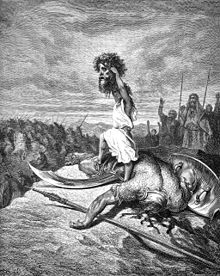| Revision as of 16:48, 7 August 2007 edit82.6.114.172 (talk)No edit summary← Previous edit | Revision as of 18:08, 7 August 2007 edit undoHeptazane (talk | contribs)Extended confirmed users1,054 edits Added reference.Next edit → | ||
| Line 1: | Line 1: | ||
| ]The '''Rephaites''' (רפאים meaning "dead ones" also known as or Zamzummites, Anakites, and Emites) were a grouping of tall peoples mentioned in the ] that lived between the ] and the ] during the time of ] ({{sourcetext|source=Bible|version=King James|book=Genesis|chapter=15|verse=17|Range=-21}}). They were considered by Joshua's scouts to be equivalent to the ] (Titans). | ]The '''Rephaites''' (רפאים meaning "dead ones" also known as or Zamzummites, Anakites, and Emites) were a grouping of tall peoples mentioned in the ] that lived between the ] and the ] during the time of ] ({{sourcetext|source=Bible|version=King James|book=Genesis|chapter=15|verse=17|Range=-21}}). They were considered by Joshua's scouts to be equivalent to the ] (Titans). | ||
| The ] and ] were sometimes considered part of this group <ref>{{bibleverse||Deuteronomy|2:10-12|31}}</ref> but sometimes separate{{ |
The ] and ] were sometimes considered part of this group <ref>{{bibleverse||Deuteronomy|2:10-12|31}}</ref> but sometimes separate <ref>{{bibleverse||Genesis|14:5|NIV}}</ref>. The Bible records that ] used the ]ites to destroy the Rephaites in {{bibleverse||Deuteronomy|2:19-21|31}}. The giant size of the Rephaites is illustrated by the bed of ], king of ] that was "made of iron and was more than thirteen feet long and six feet wide" ({{bibleverse||Deuteronomy|3:10-12|NIV}}). During the time of ], several ] warriors including ], are considered Rephaites <ref>{{bibleverse|1|Chronicles|20:4|NIV}}</ref>. | ||
| The '''Rephaites''' are represented in Hebrew by the root rp', a root which is also found within Ugaritic texts. The Ugaritic text KTU 1.108 uses the term 'king' in association with the root rp' and place names that probably correspond to Ashtaroth and Edrei in the Bible, places with which Og is associated <ref>{{bibleverse||Deuteronomy|1:4|NIV}}; {{bibleverse||Joshua|9:10|NIV}}; {{bibleverse||Joshua|12:4|NIV}}; {{bibleverse||Joshua|13:12|NIV}}, {{bibleverse||Joshua|31|NIV}}</ref>. This may provide confirmation of traditions about the royal dynasty of Og and his lineage. | The '''Rephaites''' are represented in Hebrew by the root rp', a root which is also found within Ugaritic texts. The Ugaritic text KTU 1.108 uses the term 'king' in association with the root rp' and place names that probably correspond to Ashtaroth and Edrei in the Bible, places with which Og is associated <ref>{{bibleverse||Deuteronomy|1:4|NIV}}; {{bibleverse||Joshua|9:10|NIV}}; {{bibleverse||Joshua|12:4|NIV}}; {{bibleverse||Joshua|13:12|NIV}}, {{bibleverse||Joshua|31|NIV}}</ref>. This may provide confirmation of traditions about the royal dynasty of Og and his lineage. | ||
Revision as of 18:08, 7 August 2007

The Rephaites (רפאים meaning "dead ones" also known as or Zamzummites, Anakites, and Emites) were a grouping of tall peoples mentioned in the Hebrew Bible that lived between the Nile River and the Euphrates River during the time of Abraham (Genesis 15:17). They were considered by Joshua's scouts to be equivalent to the Nephilim (Titans).
The Emites and Anakites were sometimes considered part of this group but sometimes separate . The Bible records that God used the Ammonites to destroy the Rephaites in Deuteronomy 2:19–21. The giant size of the Rephaites is illustrated by the bed of Og, king of Bashan that was "made of iron and was more than thirteen feet long and six feet wide" (Deuteronomy 3:10–12). During the time of David, several Philistine warriors including Goliath, are considered Rephaites .
The Rephaites are represented in Hebrew by the root rp', a root which is also found within Ugaritic texts. The Ugaritic text KTU 1.108 uses the term 'king' in association with the root rp' and place names that probably correspond to Ashtaroth and Edrei in the Bible, places with which Og is associated . This may provide confirmation of traditions about the royal dynasty of Og and his lineage.
The Ugaritic texts of the Legend of Danel concern the hero Danel the Rephaite, who was known as "judging the cause of the widow, adjudicating the case of the fatherless" (Ancient Near Eastern Texts, 149-51.) His soul was revived by El.
See also
Notes
- Deuteronomy 2:10–12
- Genesis 14:5
- 1 Chronicles 20:4
- Deuteronomy 1:4; Joshua 9:10; Joshua 12:4; Joshua 13:12, Joshua 31
- The name is rendered DNL.